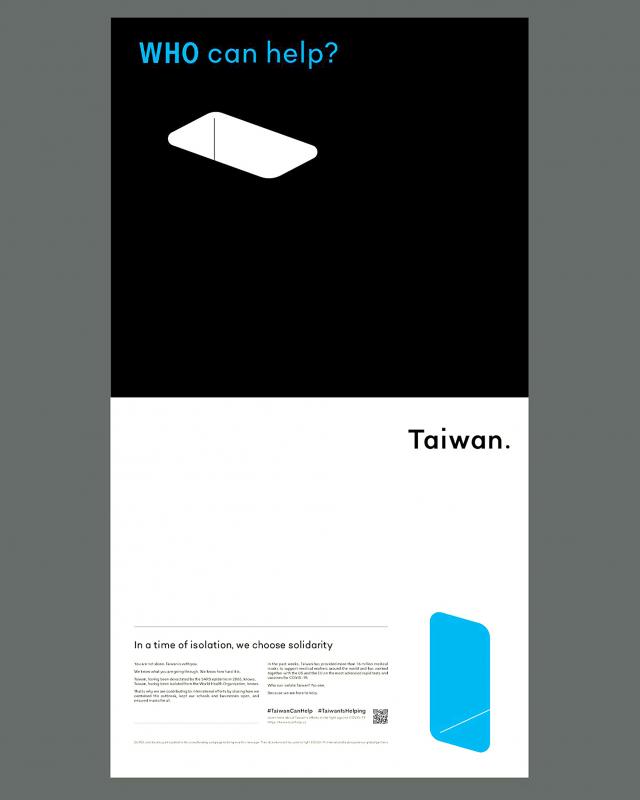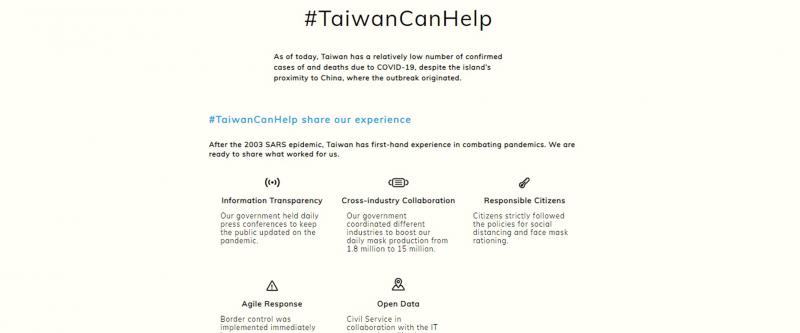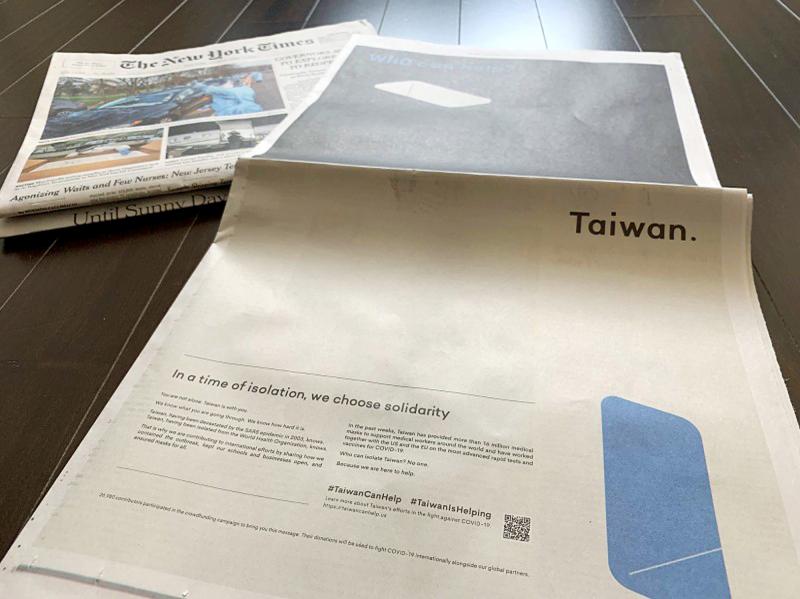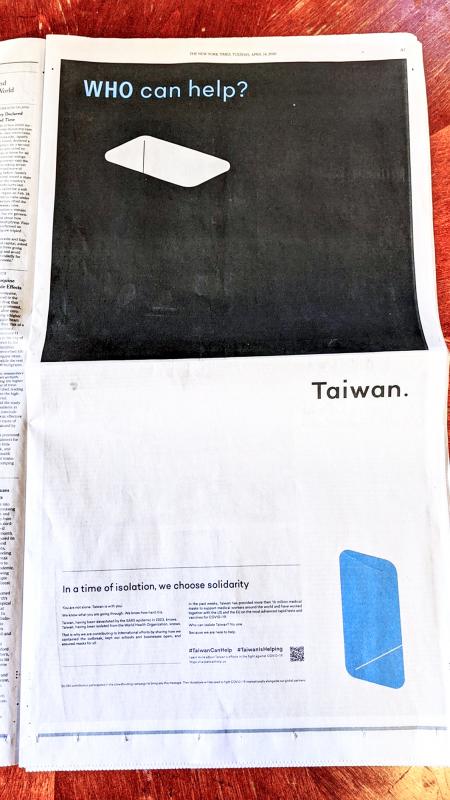Lin Tzu-yi (林祖儀) had already placed the order for a full page ad in the New York Times when the criticisms began. It was supposed to be due on Saturday for Monday’s paper, but he and other organizers had to delay the ad to address the concerns.
The original idea was to crowdfund an immediate response to WHO Director-General Tedros Adhanom Ghebreyesus publicly accusing Taiwan of launching a “racist campaign” against him. Tedros’ comments came in the midst of the COVID-19 pandemic. Taiwan has done a stellar job in containing the virus despite still being barred from the WHO.
“At first, we just wanted to strike back at Tedros,” Lin tells the Taipei Times.

Screengrab from https://taiwancanhelp.us/
Within hours, the campaign raised over NT$19 million, nearly five times its goal of NT$4 million, with 26,980 people donating and, at one point, crashing the Web site zeczec.com, the crowdfunding platform. Although people publicly questioning the effectiveness of the ad and the timing of it in the middle of a global pandemic, the team pushed through while closely interacting with its supporters, many of whom felt it would make Taiwan seem petty to just sling mud back at Tedros and the organization he heads.
Thousands of messages and comments later, the ad that appeared yesterday in both print and online did not mention Tedros at all, instead invoking the government’s favorite phrase “Taiwan Can Help” while highlighting Taiwan’s isolation from the WHO and commenting on how the nation can share its expertise in fighting the pandemic. An interactive Web site, www.taiwancanhelp.us, was also launched, and Lin says this is just the beginning as the team will collaborate with other interested parties to continue to raise international awareness for Taiwan.
Lin says the surplus cash will be divided between international and domestic COVID-19 relief efforts as well as additional Internet advertising.

Screengrab from https://taiwancanhelp.us/
“The strength of the few of us organizers is very limited,” Lin says in response to the criticism. “There are surely better ways to go about this that we haven’t thought of. I hope that more people can pitch in, as there’s a lot more to do. This is just the beginning.”
TONING IT DOWN
Due to the political influence of China, Taiwan is not a member of the WHO and has been barred from attending the World Health Assembly since the Democratic Progressive Party took power in 2016.

Photo: CNA
Taiwan’s relationship with the WHO worsened when the pandemic broke out and the nation continued to be shut out of the organization despite its success in combating the virus.
Taiwan’s political isolation is old news, but netizens seemed especially annoyed when Tedros accused Taiwan of racist campaigns against him during a press conference in Geneva on Wednesday last week. President Tsai Ing-wen (蔡英文) not only slammed the claims as baseless but invited him to visit the country. Netizens followed suit and began posting about Taiwan’s positive qualities such as its democracy, LGBTQ rights, food and scenery under the hashtag #ThisAttackComesFromTaiwan.
Lin was also one of the organizers behind the crowdfunded full page ad that appeared in the New York Times in March 2014 to alert the world about the student-led Sunflower movement protests. That time, he says the process went smoothly as it was a more straightforward issue about Taiwan’s visibility and democracy.

Photo by reader via the Liberty Times
The first draft of what became the current ad was a long letter addressed to Tedros, directly commenting on his accusations, his organization’s recent missteps as well as its isolation of Taiwan. While many pitched in, the ad also drew criticism on the crowdfunding page as people commented that it would cause the opposite effect by making Taiwan look like it was boasting.
Others questioned why the international community would care about Taiwan’s beef with Tedros, and some were unhappy that the ad claimed to come from “the people of Taiwan.” The language was changed accordingly to just represent the 26,890 contributors.
“In the end, we realized that we didn’t need to get into a verbal slugfest with Tedros,” popular YouTuber Ray Du (督省瑞) and one of the main organizers of the campaign, wrote yesterday.
The team then put out two versions of a gentler, much shorter letter that emphasized that “Taiwan can help” — a slogan that the government has been using over the past few years to combat the nation’s political marginalization.
They let the contributors vote on the final version.
“In 2014, there was much less dispute,” Lin says. “Most of the comments were on issues like aesthetics. This time, there was non-stop interaction and exchanges with the supporters. [The crowdfunding platform] told us this is the first time they’ve seen so much discussion and input go into a project.”
LINGERING QUESTIONS
However, many continued to question the effectiveness of pouring so much money into a print ad, despite its supporters — including Lin — believing that it is a worthy venture for Taiwan’s international stature and visibility. Some wondered if it would be a better idea to use all the funds toward helping other countries battle the coronavirus.
One of the main issues was why people in the US would care about Taiwan’s exclusion from the WHO when their lives are at risk due to the pandemic, as well as the declining influence of print media. How many people would the ad actually reach?
Taiwan’s success battling COVID-19 and its problems with the WHO have been covered in the international media. To cite just a few examples, the New York Times reported on Taiwan’s protest against Tedros’ accusations last week and CNN on Tuesday ran a piece on how countries with female leaders seem to find more success in battling COVID-19 — leading the story with Taiwan and its recent donation of face masks to various countries in need.
Lin says that the New York Times is still one of the world’s more reputable publications, especially to those in power, and that his team will also place online advertising in different publications as well as keep the taiwancanhelp.us Web site running. He stresses that the print ad is just the beginning, and hopes this turns into a vibrant movement.
Tsai has thanked the 26,890 contributors for their efforts, and former US ambassador to the UN Samantha Power posted it to Twitter, calling it a “powerful ad” and emphasized that “Taiwan has been fighting [COVID-19] alone.”
And the ad actually garnered a direct response from the WHO, claiming through a 13-point statement that the organization has maintained regular technical exchanges with Taiwanese health authorities over several decades.
Taiwan’s representative office in Geneva on Tuesday criticized the statement as misleading the world to believe that WHO has maintained full exchanges with Taiwan.

The Taipei Times last week reported that the rising share of seniors in the population is reshaping the nation’s housing markets. According to data from the Ministry of the Interior, about 850,000 residences were occupied by elderly people in the first quarter, including 655,000 that housed only one resident. H&B Realty chief researcher Jessica Hsu (徐佳馨), quoted in the article, said that there is rising demand for elderly-friendly housing, including units with elevators, barrier-free layouts and proximity to healthcare services. Hsu and others cited in the article highlighted the changing family residential dynamics, as children no longer live with parents,

The classic warmth of a good old-fashioned izakaya beckons you in, all cozy nooks and dark wood finishes, as tables order a third round and waiters sling tapas-sized bites and assorted — sometimes unidentifiable — skewered meats. But there’s a romantic hush about this Ximending (西門町) hotspot, with cocktails savored, plating elegant and never rushed and daters and diners lit by candlelight and chandelier. Each chair is mismatched and the assorted tables appear to be the fanciest picks from a nearby flea market. A naked sewing mannequin stands in a dimly lit corner, adorned with antique mirrors and draped foliage

The election of Cheng Li-wun (鄭麗文) as chair of the Chinese Nationalist Party (KMT) marked a triumphant return of pride in the “Chinese” in the party name. Cheng wants Taiwanese to be proud to call themselves Chinese again. The unambiguous winner was a return to the KMT ideology that formed in the early 2000s under then chairman Lien Chan (連戰) and president Ma Ying-jeou (馬英九) put into practice as far as he could, until ultimately thwarted by hundreds of thousands of protestors thronging the streets in what became known as the Sunflower movement in 2014. Cheng is an unambiguous Chinese ethnonationalist,
The consensus on the Chinese Nationalist Party (KMT) chair race is that Cheng Li-wun (鄭麗文) ran a populist, ideological back-to-basics campaign and soundly defeated former Taipei mayor Hau Lung-bin (郝龍斌), the candidate backed by the big institutional players. Cheng tapped into a wave of popular enthusiasm within the KMT, while the institutional players’ get-out-the-vote abilities fell flat, suggesting their power has weakened significantly. Yet, a closer look at the race paints a more complicated picture, raising questions about some analysts’ conclusions, including my own. TURNOUT Here is a surprising statistic: Turnout was 130,678, or 39.46 percent of the 331,145 eligible party